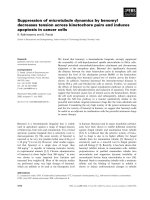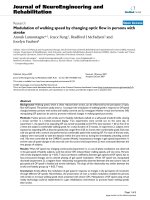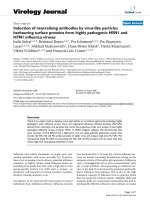Báo cáo hóa học: " Self-organization of quantum-dot pairs by high-temperature droplet epitaxy" pptx
Bạn đang xem bản rút gọn của tài liệu. Xem và tải ngay bản đầy đủ của tài liệu tại đây (265.48 KB, 5 trang )
Abstract The spontaneously formation of epitaxial
GaAs quantum-dot pairs was demonstrated on an
AlGaAs surface using Ga droplets as a Ga nano-
source. The dot pair formation was attributed to the
anisotropy of surface diffusion during high-tempera-
ture droplet epitaxy.
Keywords Quantum dots Æ Droplet epitaxy
Self-assembly of epitaxial semiconductor nanostruc-
tures has been an intensive field of research. In par-
ticular, the Stranski-Krastanov (SK) growth mode
based on the use of lattice-mismatched materials has
played an important role in the formation of nano-
structures, the investigation of quantum confinement
effects, and has made possible applications of nano-
structures [1–3]. While the SK growth mode has been a
very powerful and beautiful technique, there has been
a significant, but perhaps less well-known, parallel
development using lattice matched materials as an
alternative approach for the growth of nanostructures
called ‘‘droplet epitaxy’’ [4–7]. Here liquid metal
droplets are first formed as an intermediate growth
step before being converted into semiconductor
nanostructures. While the two growth approaches are
very different, both the SK and the droplet approach
are similar in that they both suffer from the stochastic
nature of self-assembly. As a result, the control of
spatial ordering of semiconductor nanostructures has
been extremely challenging while desirable for appli-
cations, such as, the fabrication of quantum-dot (QD)
molecules for quantum computing [8]. Consequently,
there has been much recent effort to control the lateral
arrangement of QDs using a range of techniques, such
as, lithography [9–12], templating [13, 14], and modi-
fied versions of self-organization [15–19]. Recently, the
approach of droplet epitaxy has shown promise to the
achieve local ordering of quantum nanostructures [6,
7]. In this letter, we report on the use of droplet epitaxy
and anisotropic surface diffusion to fabricate QD pairs.
All of the samples used in this study were grown in a
molecular beam epitaxy (MBE) system equipped with
reflection high-energy electron diffraction (RHEED)
and a highly accurate (±2 °C) optical transmission
thermometry system for substrate temperature deter-
mination and control. Our growth approach was to first
grow a 500 nm GaAs buffer layer on a semi-insulating
GaAs (100) substrate, followed by a 50 nm thick
Al
0.3
Ga
0.7
As layer. This was followed by the deposition
of Ga and the formation of Ga droplets at the substrate
temperature of 550 °C with the arsenic source fully
closed. We used a valved arsenic source to provide
precise and fast control for over three orders of
Z. M. Wang (&) Æ K. Holmes Æ Y. I. Mazur Æ
K. A. Ramsey Æ G. J. Salamo
Department of Physics, University of Arkansas,
Fayetteville, AR 72701, USA
e-mail:
Nanoscale Res Lett (2006) 1:57–61
DOI 10.1007/s11671-006-9002-z
123
NANO EXPRESS
Self-organization of quantum-dot pairs by high-temperature
droplet epitaxy
Zhiming M. Wang Æ Kyland Holmes Æ
Yuriy I. Mazur Æ Kimberly A. Ramsey Æ
Gregory J. Salamo
Published online: 25 July 2006
Ó to the authors 2006
magnitude of the arsenic flux. The total amount of Ga
deposited was 10.0 monolayers (MLs), corresponding
to the amount of Ga necessary for 10.0 MLs of GaAs
growth. A Ga deposition rate of 1.0 ML/s was selected
by separately observing RHEED oscillations during
the growth of GaAs.
To minimize the system’s energy, the deposited
liquid Ga forms nano droplets. In particular, by form-
ing nano-droplets the surface to vacuum and interface
to the Al
0.3
Ga
0.7
As layer, can be minimized, thereby
minimizing the system’s energy. The atomic force
microscopic (AFM) image in Fig. 1a reveals that the
Ga droplets have an average lateral size of ~125 nm, a
height of ~32 nm, and a number density of ~2.3 per
square micrometer. In forming the droplets we have
observed that the substrate temperature is a significant
parameter for the tuning of droplet density. For
example, the density of droplets increases by a factor
of six for the same amount of Ga, but deposited at the
lower temperature [7] of 380 °C as opposed to 550 °C.
We also observed that the size of the droplets could be
tuned by controlling the total amount of Ga deposited
at a fixed temperature.
Figure 1b shows an AFM image of the surface
nanostructures that are transformed from the Ga
droplets after 45 s of annealing while under an arsenic
flux of 4.2 · 10
–5
Torr. Remarkably, every Ga droplet
turns into a QD pair sitting on a 3 nm hill of GaAs.
The average separation between two QDs in a pair is
about 130 nm, comparable with the original lateral size
of Ga droplets. The tips of two QDs are about 4 nm
above the GaAs hill.
It is important to note that these results are
observed at a substrate temperature of 550 °C which is
significantly higher than previously reported droplet-
related experiments (growth temperatures of 200 °Cor
lower) [4–6]. Traditional droplet epitaxy has used low
temperatures in an effort to directly crystallize the Ga
droplets into GaAs without material redistribution. On
the other hand, in our approach we used high-tem-
perature to encourage material redistribution. In this
way we can fabricate novel semiconductor nanostruc-
tures by taking advantage of the shape instability of Ga
droplets during the transformation into GaAs dots.
The crystallization of Ga droplets proceeds at a much
faster rate at high temperature so that surface pro-
cesses on the GaAs surface can play a more important
role in the shape evolution of the GaAs nanostructure.
In particular, the GaAs forms more quickly then it can
diffuse away from the droplet. With surface tension
removed, the droplet collapses down the center of the
droplet pushing material away from the center while
restricted by diffusion. Gradually this leaves a smaller
and smaller Ga droplet on the GaAs surface acting as a
source for forming GaAs diffusing outward, forming
ridges and center-holed shaped nanostructures.
In particular, Fig. 2 shows an AFM image of the
outcome at high temperature. The AFM image shows
that the Ga droplets have fully crystallized after only
1-s of annealing at 550 °C and surface nanostructures
shaped like square-holed round coins are immediately
observed. Similar shaped nanostructures have been
observed for droplet epitaxy performed at 380 °C but
with a much longer 45-s annealing and significantly
lower arsenic flux [7]. The holed nanostructures are
observed to sit on GaAs hills due to the high As flux
and corresponding diffusion limited Ga transport. This
is confirmed since by lowering the arsenic flux, two-
dimensional (2D) growth of GaAs is enhanced and the
hills are observed to disappear. As we pointed out
Fig. 1 (a) AFM image of Ga droplets. (b) AFM image of QD
pairs formed after 45 s annealing under arsenic flux
58 Nanoscale Res Lett (2006) 1:57–61
123
previously [7], droplet epitaxy can be described as
GaAs growth supplied from a Ga nano-source (drop-
let) under a uniform arsenic flux. From the two line
profiles in Fig. 2, the heights of the coin edges are
different. In particular, the height is about 9 nm along
the [01 – 1] direction and about 4 nm along the [011]
direction.
For a typical GaAs (100) surface, it has been well
established that surface diffusion and incorporation are
anisotropic [20]. With additional annealing, the mate-
rial from the edges of the square holed nanostructure,
tend to fill the center hole but at different rates
depending on direction. AFM images in Fig. 3a and b
show a step-by-step evolution of the surface of the
nanostructures after 5 and 15 s of annealing, respec-
tively. For example, the ratio of the height of the edges
along [01 – 1] compared to [011] are seen to increase
from Fig. 3a to Fig. 3b forming a bridged pair after
15 s.
Finally, after 45 s of annealing, the bridged nano-
structure is encouraged to form a QD pair as shown in
Fig. 4a. Additional very small dots indicated by arrows
in Fig. 4a are often found to accompany the QD pair.
These are the remnants of the edges along [011]. Fig-
ure 4b is a 3D presentation of one single QD pair
formed after 45 s annealing at 590 °C. At this even
higher temperature, the QDs in the dot pairs are bigger
and more separated. The clear contour lines around
each QD pair are steps on the GaAs hill.
These QD pairs are very stable, as suggested by the
observation at different growth temperatures. How-
ever, the QD pairs tend to merge together with further
annealing.
For example, Fig. 5 shows an AFM image of the
QD pair nanostructures after 600 s of annealing.
Compared to Fig. 4a, the paired QDs have connected
together to form a rod sitting on a GaAs hill. The
steps on the GaAs hills appear very clear due to the
smoothing effects of a long-annealing period. This
behavior is not surprising. The 3D nanostructures
observed earlier in Figs. 1–4 form from the non-uni-
form supply of Ga from nano droplets. After the Ga
droplets are consumed, additional annealing tends to
smear away the nanostructures by surface diffusion
and incorporation forming the images in Fig. 5. In this
sense, as a result of the anisotropic nature of the
crystalline surface, we are able to engineer a variety
of different shaped nanostructures ranging from
Figs. 1 to 5.
In contrast to the normal droplet epitaxy at low
temperatures, high-temperature droplet epitaxy is
Fig. 2 AFM image of surface nanostructures formed after 1 s
annealing and the corresponding height profiles
Fig. 3 (a) and (b) are AFM images of surface nanostructures
formed after 5 and 15 s annealing, respectively
Nanoscale Res Lett (2006) 1:57–61 59
123
performed at substrate temperatures very close to
normal MBE growth conditions. Therefore, high
quality of GaAs/AlGaAs coherent nanostructures with
excellent optical properties is demonstrated by near-
field scanning optical microscopy. Such studies will be
reported in the near future.
In summary, by forming Ga droplets and con-
verting them into GaAs nanostructures at relatively
high temperatures, the evolution of QD pairs is
observed during subsequent annealing. The dramatic
change in shape is caused by the anisotropy nature
of surface diffusion and incorporation. High-temper-
ature droplet epitaxy is demonstrated to provide a
valuable opportunity to fabricate novel semiconduc-
tor nanostructures.
Acknowledgments We thank Dr. John L. Shultz for his tech-
nical assistance regarding the MBE system.
References
1. D. Bimberg, M. Grundmann, N.N. Ledentsov, Quantum Dot
Heterostructures (Wiley, Chichester, 1999)
2. D. Leonard, M. Krishnamurthy, C.M. Reaves, S.P. DenBa-
ars, P.M. Petroff, Appl. Phys. Lett. 63, 3203 (1994)
3. J.M. Moison, F. Houzay, F. Barthe, L. Leprince, E. Andre,
O. Vatel, Appl. Phys. Lett. 64, 196 (1993)
4. C.D. Lee, C. Park, H.J. Lee, K.S. Lee, S.J. Park, C.G.
Park, S.K. Noh, N. Koguchi, Jpn. J. Appl. Phys. 37, 7158
(1998)
5. K. Watanabe, N. Koguchi, Y. Gotoh, Jpn. J. Appl. Phys. 39,
L79 (2000)
6. T. Mano, T. Kuroda, S. Sanguinetti, T. Ochiai, T. Tateno,
J. Kim, T. Noda, M. Kawabe, K. Sakoda, G. Kido,
N. Koguchi, Nano Lett. 5, 425 (2005)
7. Zh. M. Wang, K. Holmes, J.L. Shultz, G.J. Salamo, Phys.
Stat. Sol. (a) 202, R85 (2005)
8. S.S. Li, J. B. Xia, J. L. Liu, F.H. Yang, Z.C. Niu, S.L. Feng,
H.Z. Zheng, Pro. Natl. Acad. Sci. 98, 11847 (2001)
9. H. Lee, J.A. Johnson, M.Y. He, J.S. Speck, P.M. Petroff,
Appl. Phys. Lett. 78, 105 (2001)
10. S.C. Lee, L.R. Dawson, K.J. Malloy, S.R. Brueck, Appl.
Phys. Lett. 79, 2630 (2001)
11. O.G. Schmidt, N.Y. Jin-Phillipp, C. Lange, U. Denker, K.
Eberl, R. Schreiner, H. Grabeldinger, H. Schweizer, Appl.
Phys. Lett. 77, 4139 (2000)
12. J. Liang, H. Luo, R. Beresford, J. Xu, Appl. Phys. Lett. 85,
5974 (2004)
13. H.Z. Song, T. Usuki, S. Hiros, K. Takemoto, Y. Nakata,
N. Yokoyama, Y. Sakuma, Appl. Phys. Lett. 86, 113118
(2005)
14. X. Mei, M. Blumin, M. Sun, D. Kim, Z.H. Wu, H.E. Ruda,
Q.X. Guo, Appl. Phys. Lett. 82, 967 (2003)
Fig. 4 (a) AFM image of QD pairs formed after 45 s annealing.
(b) A single QD pair formed after 45 s annealing at 590 °C
Fig. 5 AFM image of surface nanostructures formed after
10 min annealing
60 Nanoscale Res Lett (2006) 1:57–61
123
15. J. Tersoff, C. Teichert, M.G. Lagally, Phys. Rev. Lett. 76,
1675 (1996)
16. M. Schmidbauer, M. Hanke, R. Kohler, Phys. Rev. B 71,
115323 (2005)
17. R. Songmuang, S. Kiravittaya, O.G. Schmidt, Appl. Phys.
Lett. 82, 2892 (2003)
18. Z.M. Wang, K. Holmes, Yu. I. Mazur, G.J. Salamo, Appl.
Phys. Lett. 84, 1931 (2004)
19. Zh.M. Wang, Sh. Seydmohamadi, J.H. Lee, G.J. Salamo,
Appl. Phys. Lett. 85, 5031 (2004)
20. E.J. Heller, Z.Y. Zhang, M.G. Lagally, Phys. Rev. Lett. 71,
743 (1993)
Nanoscale Res Lett (2006) 1:57–61 61
123









